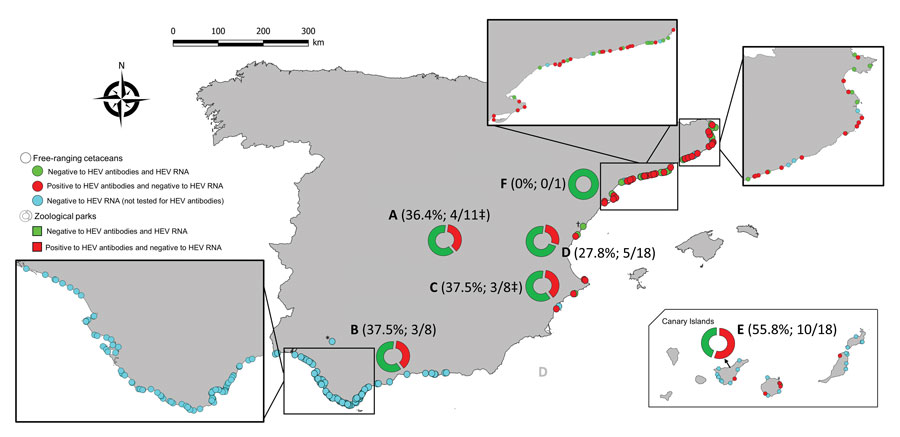Hepatitis E Virus Infections in Free-Ranging and Captive Cetaceans, Spain, 2011–2022
Javier Caballero-Gómez, Antonio Rivero-Juarez

, Adrián Beato-Benítez, Carolina Fernández-Maldonado, Mariano Domingo, Daniel García-Párraga, Antonio Fernández, Eva Sierra, Rainer G. Ulrich, Eva Martínez-Nevado, Cecilia Sierra-Arqueros, Rocío Canales-Merino, Antonio Rivero, and Ignacio García-Bocanegra
Author affiliations: Maimonides Institute for Biomedical Research of Cordoba, Reina Sofía University Hospital, University of Córdoba, Córdoba, Spain (J. Caballero-Gómez, A. Rivero-Juarez, A. Rivero); (J. Caballero-Gómez, A. Rivero-Juarez, A. Rivero, I. García-Bocanegra); GISAZ-ENZOEM, University of Córdoba, Córdoba (J. Caballero-Gómez, A. Beato-Benítez, I. García-Bocanegra); CIBERINFEC, Carlos III Health Institute, Madrid, Spain Seashore Environment and Fauna, Cádiz, Spain (C. Fernández-Maldonado); Andalusian Marine Environment Management Center, Ministry of Agriculture, Livestock, Fisheries and Sustainable Development, Cádiz, Spain (C. Fernández-Maldonado); Veterinary Pathology Diagnostic Service, Autonomous University of Barcelona-Bellaterra, Barcelona, Spain (M. Domingo); Oceanographic Foundation of the Valencian Community and Avanqua Oceanographic, Valencia, Spain (D. García-Párraga); Atlantic Cetacean Research Center, Institute of Animal Health, University of Las Palmas de Gran Canaria, Trasmontaña, Las Palmas, Spain (A. Fernández, E. Sierra); Federal Research Institute for Animal Health/German Center for Infection Research, Greifswald-Insel Riems, Germany (R.G. Ulrich); Madrid Zoo, Madrid, Spain (E. Martínez-Nevado); Selwo Marina, Málaga, Spain (C. Sierra-Arqueros); Mundomar Benidorm, Alicante, Spain (R. Canales-Merino).
Main Article
Figure 2

Figure 2. Spatial distribution of cetaceans sampled in a survey of HEV in 304 cetaceans belonging to 13 species in Spain during n 2011–2022. The frequency of seropositivity and number of seropositive and total animals analyzed at each zoological park (A–F) is shown in parentheses. Callouts show detail of sampling along the Atlantic and Mediterranean coastlines. *Animal sampled in the Guadalquivir River. †This animal was not analyzed by reverse transcription PCR. ‡One of the sampled animals of this zoo park was not tested by reverse transcription PCR. HEV, hepatitis E virus.
Main Article
Page created: October 24, 2022
Page updated: November 21, 2022
Page reviewed: November 21, 2022
The conclusions, findings, and opinions expressed by authors contributing to this journal do not necessarily reflect the official position of the U.S. Department of Health and Human Services, the Public Health Service, the Centers for Disease Control and Prevention, or the authors' affiliated institutions. Use of trade names is for identification only and does not imply endorsement by any of the groups named above.
